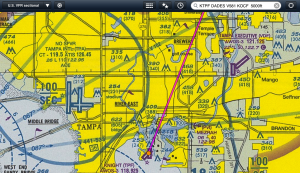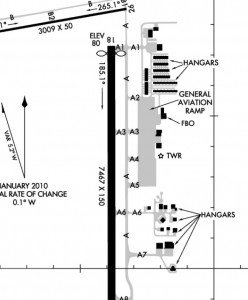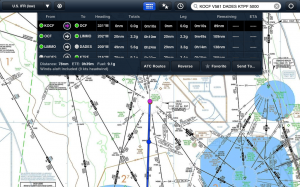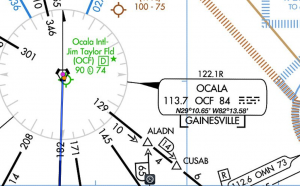Today I want to take you along on an educational and entertaining flight from Tampa’s Peter O. Knight Airport to Ocala, Florida. This is a first in a new series of videos to entertain, educate, and promote your passion for flying.
In this video you will discover :
- Some advantages and disadvantages of obtaining your Instrument clearance in the air after departing VFR.
- How to navigate around Class Bravo airspace while waiting to receive your IFR clearance.
- Transitioning from VFR to IFR and some clearances that can be confusing.
- How to operate using the new control tower at Ocala airport.
- A great place to have breakfast or lunch at the Tailwind Cafe.
The purpose of our flight was to practice filing an IFR flight plan and flying in the air traffic control system. Additionally we simply wanted to enjoy the scenery and find a good airport restaurant for breakfast since we were both hungry.
We called ahead to the Tailwind Cafe to verify the restaurant was open. From past experience we have departed for a hundred dollar hamburger only to find the restaurant recently closed. Luckily this cafe has been open for a long time because it not only relies on airport traffic but locals to come visit.
After obtaining a weather briefing we filed IFR for two reasons first for the practice and second since Ocala was marginal VFR due to low visibility. At our departure airport we could have picked up our IFR clearance but from past experience this can take some time and the weather along our route was VFR.
 We departed runway 04 and climbed to one thousand feet. After clearing the traffic pattern at Peter O Knight we called Tampa approached control and stated “Tampa Approach Cessna 12345 is off of Peter O. Knight ready to copy IFR to Ocala.”
We departed runway 04 and climbed to one thousand feet. After clearing the traffic pattern at Peter O Knight we called Tampa approached control and stated “Tampa Approach Cessna 12345 is off of Peter O. Knight ready to copy IFR to Ocala.”
Tampa Approach : “Cessna 12345 squawk 3537, maintain VFR at or below four thousand”.
We read back, “Maintain VFR at or below 4000, squawking 3537.” After the transmission I could see my student turn to me with a puzzled look which started a discussion as to whether we could climb to 4000 now. The answer is no because we were still operating below the class bravo airspace and we have not been cleared into class bravo.
Even though we requested an IFR clearance we are still operating VFR. Additionally, we never heard the key words “cleared into class bravo airspace”
Shortly afterwards we received an additional clearance form Air Traffic Control (ATC), “Cessna 12345 maintain one thousand six hundred, cleared into bravo airspace”. We read back “up to one thousand six hundred, cleared into bravo” and begin our climb.
Now we are cleared into bravo airspace but must still maintain VFR until we receive our IFR clearance which comes shortly after we climb to sixteen hundred with the following communication:
ATC : “Cessna 12345 are you ready to copy your clearance”
Cessna : “Cessna 12345 ready to copy”
ATC “Cessna 12345 is cleared to Ocala airport as filed except maintain five thousand”
Us: “Cessna 12345 as filed except maintain five thousand”.
ATC : “Cessna 12345 climb now to five thousand”
Cessna: “Climb to five thousand, Cessna 12345”
We are on our way and in the IFR system. The flight was smooth and uneventful but with the approaching cold front I was glad we filed IFR since a layer of haze reduced our visibility.
As we approached Ocala we listened to ATIS on our number two radio and began to set up the GPS for a visual to runway 18. Even though it would be a visual approach it is a good idea to load an approach into the GPS for additional conformation that we are landing on the correct runway.
The control tower at Ocala was completed in May of 2011 and was put in place due to the demand from the local horse trade and in hopes of increasing business now that it does have a tower. The tower is a simple but attractive design keeping with the style of the area.
 While approaching Ocala air traffic control told us to expect the visual to runway 18. We said we had the runway in sight and they subsequently told us to contact tower.
While approaching Ocala air traffic control told us to expect the visual to runway 18. We said we had the runway in sight and they subsequently told us to contact tower.
We contacted tower by saying “Ocala tower Cessna 12345 is with you for the visual 18.” Ocala tower does not have radar so they asked us if we would prefer the left or right downwind to runway 18. We asked for a right downwind and kept it in tight so I could bring you this video of the tower and the runway.
After landing we turned off the runway and were asked to contact ground. After clearing the runway we completed our after landing checklist and then contacted tower saying “Ocala ground Cessna 12345 is clear of one eight and we would like to taxi to the restaurant” The control asked “are you familiar”. We then stated that it has been a long time since we had been here and need directions.
The controller then told us to taxi down alpha to alpha 3 and the restaurant is on the ramp near the Shell sign. After entering the ramp I began looking for the Landmark FBO frequency but luckily there was someone on the ramp that guided us into a parking space.
After securing the aircraft we walked into the Landmark Aviation FBO past a unique display of jockey figurines lining the concrete walkway. Inside we were greeted with a warm smile from the person behind the counter who took our tail number and told us to enjoy our lunch. No landing fee if you eat at the cafe.
 The Tailwind Cafe is charming and brings back many memories of my bringing students here to have lunch on one of the many cross countries I did to this airport. One of the wonderful things about flying is that we can pick up and go to these small out of the way places for lunch in under an hour.
The Tailwind Cafe is charming and brings back many memories of my bringing students here to have lunch on one of the many cross countries I did to this airport. One of the wonderful things about flying is that we can pick up and go to these small out of the way places for lunch in under an hour.
One interesting item which adds to the nostalgic charm is the many wings which flight crews have given to the cafe to put on the cork board behind the counter. We enjoyed a leisurely breakfast and watched airplanes out the large window highlighted by a hawker jet pulling up to the entrance before we paid the bill.
The Return Flight.
 We filed IFR and asked for direct to destination on the way back to Peter O. Knight. We started the engine, listened to ATIS and asked for our clearance from ground control. Since there is no clearance delivery at Ocala we use the ground control frequency for our clearance. We received the clearance “...Cleared To Tampa Peter O. Knight Airport via Ocala Victor 481, DADES, Direct, Maintain two thousand, expect four thousand ten minutes after departure, squawk 3845.
We filed IFR and asked for direct to destination on the way back to Peter O. Knight. We started the engine, listened to ATIS and asked for our clearance from ground control. Since there is no clearance delivery at Ocala we use the ground control frequency for our clearance. We received the clearance “...Cleared To Tampa Peter O. Knight Airport via Ocala Victor 481, DADES, Direct, Maintain two thousand, expect four thousand ten minutes after departure, squawk 3845.
This is different from our original filed flight plan so I put it into my flight planning and charting software, Fore Flight, and noticed only a few minutes extra in our planned flight time with us still landing with over three hours of fuel so we were go to go.
When you are given a reroute you should always recheck your fuel burn to determine if you will need any extra fuel. Also, one of the benefits to using an electronic charting system such as Fore Flight is the ability to simply enter the new route and you will get a navigation log with the current winds provided you are connected to the internet.
 The other important thing to remember is you must now program your flight plan into your database in your GPS. There are of course a few options in our case, we could have simply tuned the VOR frequency and then dialed in the radial, departed and then put the remainder of the flight plan in our GPS.
The other important thing to remember is you must now program your flight plan into your database in your GPS. There are of course a few options in our case, we could have simply tuned the VOR frequency and then dialed in the radial, departed and then put the remainder of the flight plan in our GPS.
There are two reasons I caution against operating this way. First, we have filed our flight plan with an equipment suffix of “/G” and we must be able to quickly navigate direct to a waypoint if given an ATC clearance to do so. Second, we should be concentrating on flying the plane while in flight and looking for traffic instead of with our head down looking at the GPS and programming a route we could have entered on the ground.
Since today there where two pilots in the airplane my job was to program the GPS and my flying partner was flying. I was in charge of placing the flight plan into the GPS. We taxied out to runway 18 and were soon after cleared for takeoff.
One thing you should review if you have simply been using your GPS for direct to navigation is how to activate a leg in a flight plan. This may sound trivial but while you are being radar vectored during a climb is the worst time to be experimenting with how to activate a leg.
If I asked you to explain how to activate a leg in your GPS and you cannot immediately respond I encourage you to get out your manual and review the procedure. Keep in mind there may be a few ways to activate a leg in your GPS similar to the GNS 430 we use. If you have a simulator on your computer I encourage you to get it out after this video and practice activating a leg in your flight plan. Interestingly you would be surprised how many people don’t know how to activate a leg in their electronic navigation system so don’t feel bad if you don’t remember. Simply review it now.
 After we reviewed how to activate a leg in our GPS in case we were told to intercept the airway we were given the simple clearance to climb to five thousand and direct DADES. At least we were prepared to intercept the airway.
After we reviewed how to activate a leg in our GPS in case we were told to intercept the airway we were given the simple clearance to climb to five thousand and direct DADES. At least we were prepared to intercept the airway.
It was a beautiful day to fly! We learned a few things on this fun flight to Ocala for breakfast and I hope my sharing this flight with you today has been both informative and entertaining. If you are instrument rated and current I encourage you to file an IFR flight plan next time you fly even if it is a clear VFR day.
First, by actually flying in the system and talking to air traffic control you will gain much experience talking to ATC which is something we all could benefit from. Second, when we file a flight plan, whether IFR or VFR, and you have a problem and land off airport, search and rescue will first begin searching along your route. Even better if you pick up your IFR clearance and operate in the system it is like having VFR flight following at all times and you are sure that search and rescue will be dispatched immediately by ATC if you were to land off field. Third, if you are flying IFR and you see a cloud you will not have to alter course due to VFR cloud clearance.
I file an IFR flight plan every time I fly even if I don’t pick up my clearance. With the new electronic flight bags and planning software such as Fore Flight I can quickly put my flight plan in my iPad, get a weather briefing, and file my flight plan all with a few simple key strokes.
My name is Carl Valeri aviation blogger and co host of the Stuck Mic AvCast. I hope you enjoyed coming with me on this flight to Ocala and the Tailwind Cafe. I have links to the images shown on this video at ExpertAviator.com where you can also find links to the airport restaurant and the charts mentioned.
This is a first in a series of educational videos I will be presenting where I take you along with me on a flight. My purpose is to both entertain and educate you. For a transcript of this video and links to items mentioned in this video visit ExpertAviator.com. You also will find links to the Stuck Mic AvCast and aviation podcast about learning to fly, living to fly, and loving to fly!
I hope to see you again soon. Clear skies and safe flying!
For More Information:
Tailwind Cafe Facebook Page
Landmark Aviation Ocala Airport
Visit Our Sponsors:


Comments on this entry are closed.
Great post. I like reading posts like this when lessons are combined with pleasure. It reminds us the main reasons why we learn to fly at the first place. Keep these posts coming!!!
Private license with non current IFR rating.